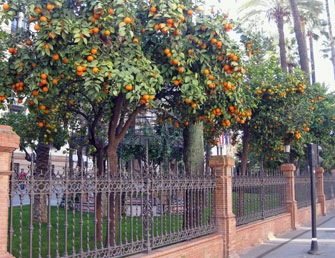
I had never been to Seville before, so when Nancy and I went there for Christmas, I saw it as an opportunity: an opportunity to discover a legendary city, to learn about its traditions, sample exotic foods, massacre an unfamiliar language and generally absorb the atmosphere of a justly proud millennia-old culture. And then make fun of it in the shallowest, most puerile possible way.
Since I live in Paris, my perception of Seville was colored by the undercurrent of a recurrent question: what’s Seville got that Paris doesn’t? Other than the elephant in the flamenco hall, by which I mean the bull in the bullring, I can sum up the difference in four words, starting with…
1) Oranges
There are orange trees just about everywhere in the historic old town of central Seville, lining the streets, shading the sidewalks and adding a splash of color to the courtyards:
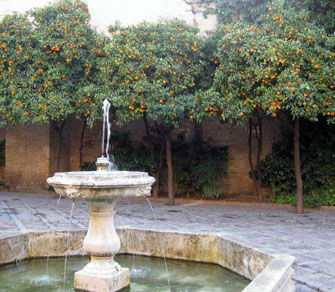
Isn’t that great? Any time you want an orange, all you have to do is reach up, pick one, peel it and take a big bite.
And then spit it out, double over retching and beg for a bottle of oven cleaner to rinse out your mouth.
You really don’t want to eat one of those oranges. Or, to be perfectly accurate, you really don’t want to eat one of those oranges unless someone is paying you €175 per section to gag it down.
Why? The answer is very simple, so here’s an overly complicated explanation:
Back in the 1960s, the Florida Citrus Commission ran ads with the slogan, “A day without orange juice is like a day without sunshine.” If the Andalusia Citrus Commission were to emulate this concept, they would have to say, “A day without an orange from Seville is like a day without dipping your tongue into a vat of sheep dip.”
These are not sweet oranges. They are, in fact, the exact opposite: Citrus aurantium, also known as “sour orange” for obvious reasons, “bigarade orange” for less obvious reasons and, by some inexplicable coincidence, “Seville orange.”
They look just like regular eating/squeezing oranges, but they have no fructose in them whatsoever — they are as sour and astringent as a lemon. In fact, the one I tasted in the interest of journalistic research (which sounds better than “in the interest of naive dickheadedness”) was as sour as three lemons, two green apples and a puritan at a toga party.
So why don’t they tear out all those trees and plant something at least vaguely edible, like kumquats? The answer is rather complicated, so here’s an overly simple explanation:
Although they’re no good for eating fresh off the tree, sour oranges are prized for making marmalade and for their essential oil, which is used in fragrances and flavors. According to Wikipedia, extracts of sour orange are also used in herbal medicine “as a stimulant and appetite suppressant.”
This makes perfect sense to me: one suck on a Seville orange, and you’ll be stimulated to throw it away as far and as fast as you can, after which you won’t want to eat anything for a week.
Fortunately, throwing half-eaten fruit in Seville is unlikely to cause any stains or hard-to-clean mess because virtually everything in the city is covered with:
2) Tiles
All over Seville, there are decorative ceramic tiles literally everywhere you look. Tiles are used to identify the streets:

To identify the buildings on those streets:
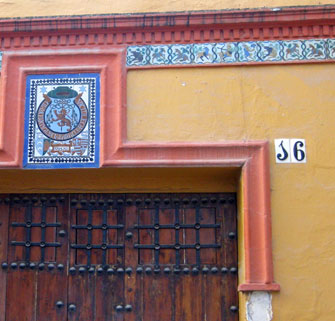
To identify the businesses in those buildings:
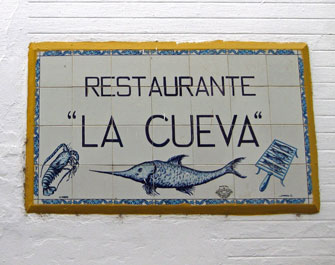
And to tell you when the tiles were put on:
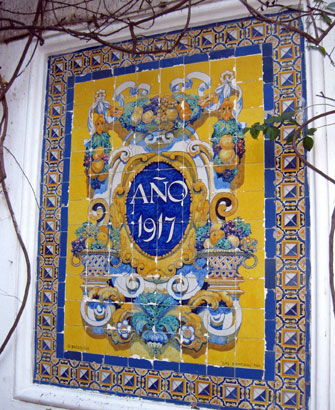
You can’t get away from the tiles. Many buildings are nearly covered with them, both outside…
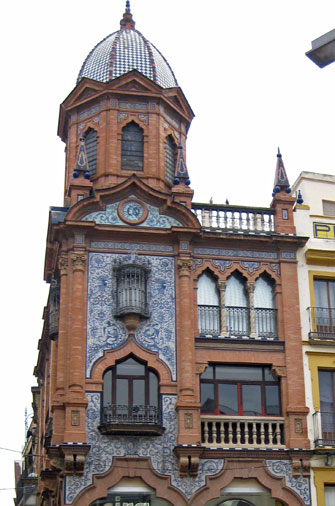
and in:
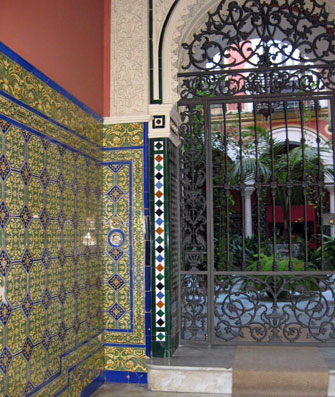
They’re even used to make little glazed grottoes for vending machines:
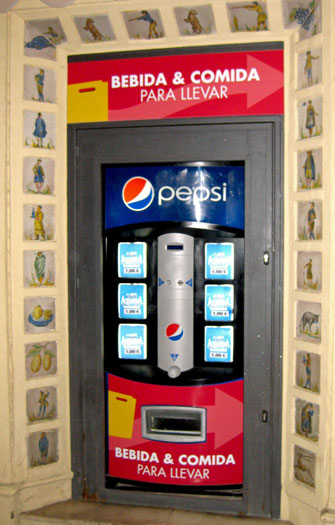
And, in a strange cultural twist, to commemorate U.S. dairy industry advertising campaigns:
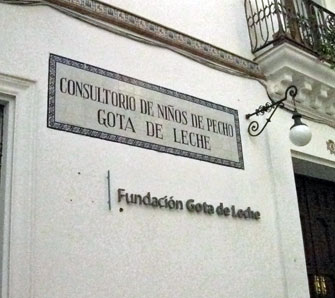
They are, invariably, stunningly beautiful. But if you’re in Seville and, for whatever reason, grow sick of seeing tiles, the only solution is to stare at the sky. And even then, when you go to the window you’ll see tiles on the sill:
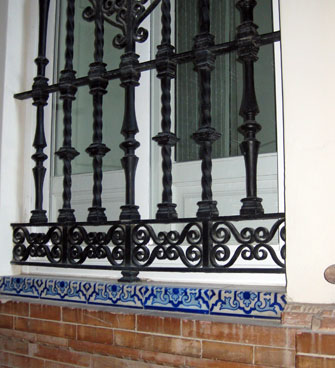
And when you raise your gaze, you’ll see tiles under your neighbor’s balcony:
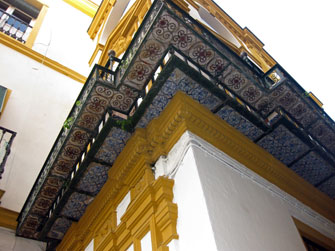
If you’re religious, you could try praying for fewer tiles, but guess what the little streetside shrines and altars in Seville are made of? That’s right:
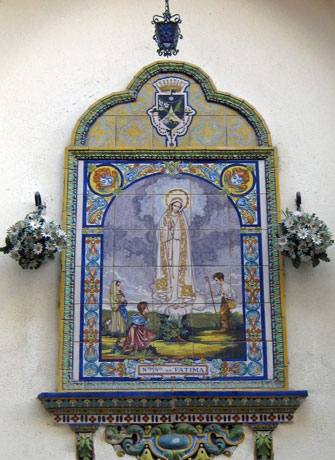
It’s enough to make you want to climb the walls. But you can’t, because they’re covered with tiles.
And what few parts of them aren’t tiled over are encrusted with:
3) Rocks
Specifically, old rocks. More specifically, old Roman rocks. A couple of thousand years ago, Seville was an outpost of the Roman Empire, and the modern-day city has incorporated sections of the Caesarean ruins into its architecture.
Apparently, life in ancient Seville was a constant grind, judging from the number of old buildings built on millstones:
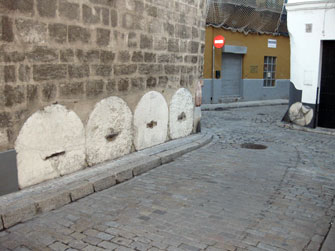
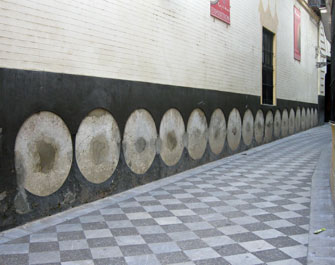
Even today, life for the residents on some of the narrower streets is at least an intermittent grind:

As you can see, many Sevillians are just scraping by, for which reason the smarter homeowners in the old town have reinforced their facades with other bits of flotsam from the fall of Rome:
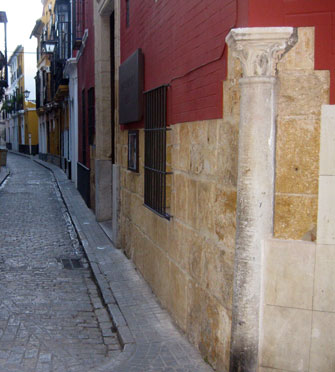

Narrow streets, tight corners… Drivers in Seville are well-advised not to lean out of their vehicles, lest they lose their…
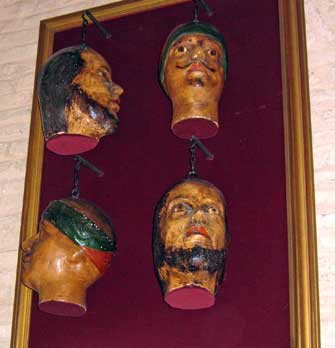
4) Heads
I realize that at first glance this looks like something that Seville and Paris have in common, but there is an important difference here: these cabezas are not involuntary organ donations from counter-revolutionaries (a topic that I discussed in a previous article), but rather life-size wooden replicas that were used in a sort of jousting sport that was introduced as an alternative to bullfighting a few centuries ago. It didn’t catch on.
I saw this nonetheless gruesome-looking display in the Museo Taurino, the museum in the city’s bullfighting arena, which is as close I got to seeing an actual bullfight. And about as close as I want to get (I’m not much interested in sweat sports, let alone blood sports).
I have to confess that I also spent an entire week in Seville without experiencing that other mainstay of Andalusian entertainment, flamenco. I like flamenco, and there were places all over town offering nightly shows, but they didn’t tempt me for some reason.
Actually, they didn’t tempt me for a very specific reason: most of them looked like tourist traps.
Sorry! I shouldn’t say that. That’s just sour grapes. Or, as they say in Seville, that’s just sweet oranges.
© 2013 Paris Update
FavoriteAn album of David Jaggard’s comic compositions is now available for streaming on Spotify and Apple Music, for purchase (whole or track by track) on iTunes and Amazon, and on every other music downloading service in the known universe, under the title “Totally Unrelated.”
Note to readers: David Jaggard’s e-book Quorum of One: Satire 1998-2011 is available from Amazon as well as iTunes, iBookstore, Nook, Reader Store, Kobo, Copia and many other distributors.
